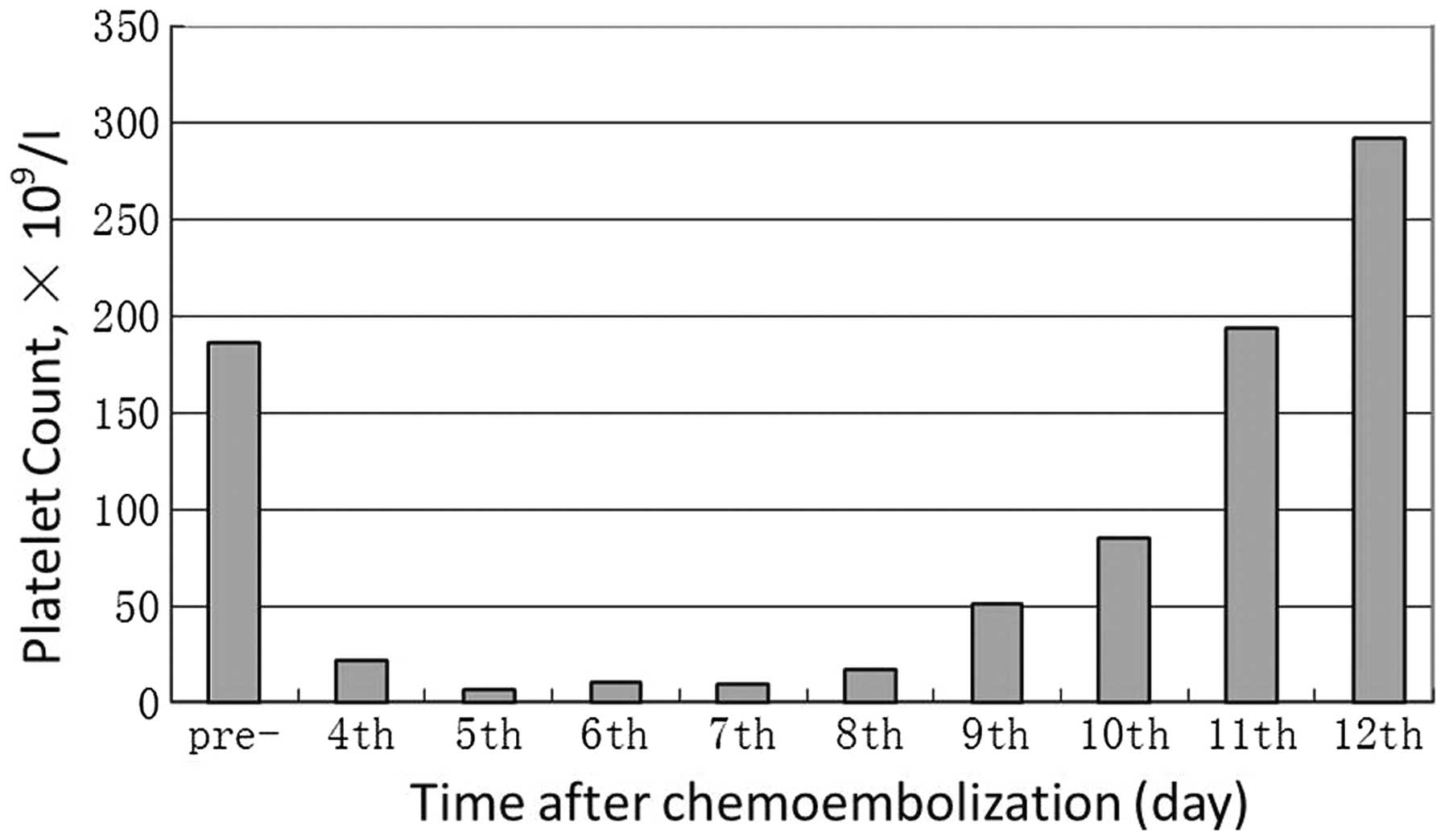
Acute thrombocytopenia: An uncommon complication occurring following transarterial chemoembolization in a patient with neuroendocrine hepatic metastases
- Authors:
View Affiliations
Affiliations: Department of Radiology, Ningbo Beilun People's Hospital, Ningbo, Zhejiang 315800, P.R. China, Department of Radiology, Shanghai 85 Hospital, Shanghai 200052, P.R. China
- Published online on: May 19, 2015 https://doi.org/10.3892/ol.2015.3232
-
Pages:
247-249
-
Copyright: © Xie
et al. This is an open access article distributed under the
terms of Creative
Commons Attribution License.
Metrics: Total
Views: 0 (Spandidos Publications: | PMC Statistics: )
Metrics: Total PDF Downloads: 0 (Spandidos Publications: | PMC Statistics: )
This article is mentioned in:
Abstract
Neuroendocrine tumors are a group of carcinomas that secrete various polypeptides with hormonal activity. A significant percentage of patients already have hepatic metastases at the time of initial diagnosis, and 80‑90% of these tumors are inoperable at the time of presentation. Transarterial chemoembolization (TACE) is the preferred approach for the management of neuroendocrine hepatic metastases. Although the technique is relatively safe, it is associated with several complications. The present study reported the case of a patient with neuroendocrine hepatic metastases who developed acute thrombocytopenia following TACE. To the best of our knowledge, acute thrombocytopenia occurring after TACE in a patient with neuroendocrine hepatic metastases has not been previously reported. In the present study, the hypothetical etiopathogenetic mechanisms were also discussed.
View References
|
1
|
Loewe C, Schindl M and Cejna M: Permanent
transarterial embolization of neuroendocrine metastases of the
liver using cyanoacrylate and lipiodol: assessment of mid- and
long-term results. AJR Am J Roentgenol. 180:1379–1384. 2003.
View Article : Google Scholar : PubMed/NCBI
|
|
2
|
Venook AP: Embolization and
chemoembolization therapy for neuroendocrine tumors. Curr Opin
Oncol. 11:39–44. 1999. View Article : Google Scholar
|
|
3
|
Kress O, Wagner HJ, Wied M, et al:
Transarterial chemoembolization of advanced liver metastases of
neuroendocrine tumors: a retrospective single centre analysis.
Digestion. 68:94–101. 2003. View Article : Google Scholar : PubMed/NCBI
|
|
4
|
Proye C: Natural history of liver
metastasis of gastroenteropancreatic neuroendocrine tumors: place
for chemoembolization. World J Surg. 25:685–688. 2001. View Article : Google Scholar : PubMed/NCBI
|
|
5
|
Blonski WC, Reddy KR, Shaked A, et al:
Liver transplantation for metastatic neuroendocrine tumor: a case
report and a review of literature. World J Gastroenterol.
11:7676–7683. 2005.PubMed/NCBI
|
|
6
|
Modlin IM and Sandor A: An analysis of
8305 cases of carcinoid tumors. Cancer. 79:813–829. 1997.
View Article : Google Scholar : PubMed/NCBI
|
|
7
|
Vogl TJ, Naguib NN, Zangos S, et al: Liver
metastases of neuroendocrine carcinomas: interventional treatment
via transarterial embolization, chemoembolization and thermal
ablation. Eur J Radiol. 72:517–528. 2009. View Article : Google Scholar : PubMed/NCBI
|
|
8
|
Moertel CG, Johnson CM, McKusick MA, et
al: The management of patients with advanced carcinoid tumors and
islet cell carcinomas. Ann Intern Med. 120:302–309. 1994.
View Article : Google Scholar : PubMed/NCBI
|
|
9
|
Madoff DC, Gupta S, Ahrar K, Murthy R and
Yao JC: Update on the management of neuroendocrine hepatic
metastases. J Vasc Interv Radiol. 17:1235–1249; quiz 1250. 2006.
View Article : Google Scholar : PubMed/NCBI
|
|
10
|
Touzios JG, Kiely JM, Pitt SC, et al:
Neuroendocrine hepatic metastases: does aggressive management
improve survival. Ann Surg. 241:776–783. 2005. View Article : Google Scholar : PubMed/NCBI
|
|
11
|
Bussel JB: Autoimmune thrombocytopenic
purpura. Hematol Oncol Clin N Am. 4:179–191. 1990.
|
|
12
|
Kim HD and Boggs DR: A syndrome resembling
idiopathic thrombocytopenic purpura in 10 patients with diverse
forms of cancer. Am J Med. 67:371–377. 1979. View Article : Google Scholar : PubMed/NCBI
|
|
13
|
Schwartz KA, Slichter SJ and Harker LA:
Immune-mediated platelet destruction and thrombocytopenia in
patients with solid tumors. Br J Haematol. 51:17–24. 1982.
View Article : Google Scholar : PubMed/NCBI
|
|
14
|
Kelton JG, Meltzer D, Moore J, et al: Drug
induced thrombocytopenia is associated with increased binding of
IgG to platelets both in vivo and in vitro. Blood. 58:524–529.
1981.PubMed/NCBI
|










